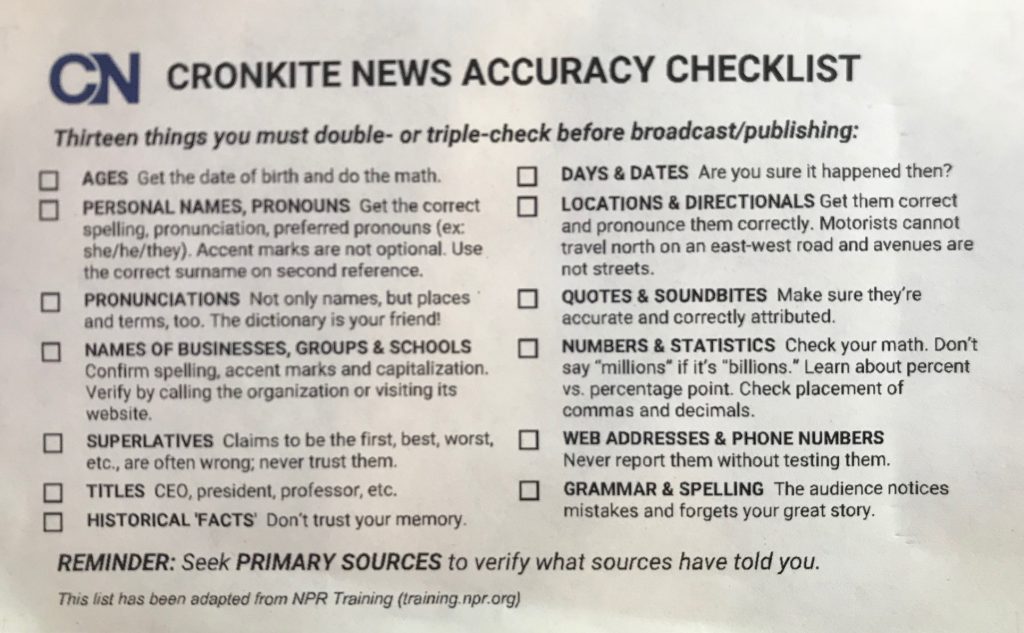Hospital intensive care units perform medical miracles daily. But in a fraction of cases, minor infections from major surgery are fatal to patients. In 2001, Peter Pronovost, a critical care specialist at Johns Hopkins Hospital in Baltimore, had an idea for reducing patient infections resulting from the insertion of in-line tubes during intensive care. He created a five-step checklist with steps so simple – including “wash your hands” – that they bordered on insulting to the health care professionals. But they worked.
They worked so well, in fact, that the results were hard to believe. Over the course of a year, the five-step checklist was estimated to have prevented 43 infections and saved eight lives at that one hospital. Pronovost then worked with teams to create other checklists and found that simply having doctors and nurses create their own checklists improved care so much that it cut in half the time patients spent in the intensive care unit.
Pronovost eventually was given the opportunity to apply his checklist strategy at ICUs across Michigan. In just the first three months, infection rates dropped by 66%, and over the course of 18 months, it’s estimated that more than 1,500 lives were saved by implementing these checklists.
These are just two examples of the power of simple checklists shared by author and surgeon Atul Gawande in The Checklist Manifesto: How to Get Things Right. Those benefits are not limited to medicine. Whether it’s flying a plane or building a skyscraper, Gawande makes a compelling case that in many fields of expertise, the primary problem has become the degree of complexity rather than a lack of expertise.
“Substantial parts of what software designers, financial managers, firefighters, police officers, lawyers and, most certainly, clinicians do are now too complex for them to carry out reliably from memory alone,” Gawande wrote.
Get the Stupid Stuff Right
Journalism isn’t brain surgery, as news directors like to point out. But newsrooms could learn a lot from the way experts in other fields have benefited from the simple power of the checklist.
In fact, newsrooms teem with tasks ripe for a checklist approach. Repetitive tasks are one area of opportunity.
“We are not built for discipline, we are built for novelty and excitement, not for careful attention to detail. Discipline is something we have to work at,” Gawande observed.
Increasingly complex workflows are another: “The volume and complexity of what we know has exceeded our individual ability to deliver its benefits correctly, safely, or reliably.”
Finally, some rote and repetitive tasks are so easy they’re easy to miss. As Gawande put it, “you want people to make sure to get the stupid stuff right.”
The Accuracy Checklist
Here in the Cronkite Newsroom at Arizona State University, the most important checklist is the Accuracy Checklist. Lori Todd, Digital Director and Professor of Practice at Cronkite News, helped develop the checklist, adapted from one she used in her previous role as Senior Social Media Editor at National Public Radio. Todd and team edited the list to make it work for all platforms. The purpose of the checklist is to help student journalists develop the habit of fact-checking. Todd notes that students themselves helped enhance the checklist, for example adding a check for preferred personal pronoun. Cronkite’s accuracy checklist is a perfect example of the “wash your hands” type of checklist, filled with simple and even mundane checks (spelling of name and title, checking dates.) Yet any editor will tell you these are the very errors that drive journalists crazy – and erode trust in media.

At TEGNA, which operates 49 local television stations in 41 markets, checklists have become a strategic tool. Stations use checklists to not only improve execution at daily tasks but also to refocus newsroom culture on putting the audience first. (Note: I previously worked for TEGNA as VP for digital content, so I’m familiar with such checklists.) The typical station uses three essential checklists, each with its own purpose, according to Joanie Vasiliadis, TEGNA’s vice president of digital content, who has led the checklist efforts. Stations have checklists for breaking news, start of shift and SEO optimization.
Breaking News Checklist
“Breaking news can be very chaotic,” Vasiliadis noted. “There’s lots going on at one time. The checklist makes sure we’re not skipping the foundational things.” Newsrooms are always adding new tools, which require updated workflows. “The checklist helps us make sure we are doing the basics,” Vasiliadis said. “It’s just so easy to forget in the craziness of breaking news.”
Start of Shift Checklist
Producers at TEGNA stations use this checklist to help foster smooth handoffs. Producers can be confident they’ve hit all the important items as they begin their day, such as checking in with reporters, engaging in social listening, and ensuring that digital stories are optimized and have video. “The checklist is a living, breathing document because our world is always changing,” Vasiliadis said.
SEO Optimization Checklist
Different news organizations prioritize different story elements and define story excellence differently, so story optimization checklists are specific to each organization. Some might focus on video, others on search-engine optimization and still others on multimedia or interactivity or word count. TEGNA producers have a checklist that helps them ensure stories contain the key elements (word length, optimized titles and descriptions, etc.) to insure good SEO ranking. The ideal story checklist is one that best reflects that news organization’s priorities.
Creating Effective Checklists
Process counts when creating a checklist for a newsroom. Vasiliadis led a collaborative process that involved all the key stakeholders, from EPs and news directors to digital producers, reporters and photographers. The first draft then was tested in one newsroom, and employees were asked for feedback, which led to refinements. Only then were the checklists rolled out to all of its stations.
“It was a multi-month process,” acknowledged Vasiliadis, who believes the extra time invested in the inclusive process resulted in more effective checklists.
Aesthetics also count. Vasiliadis said the list evolved from “chicken scratch” to a Word document to – in its final form – a sharply designed single-page list polished by the graphics team that easily fits on a desk or desktop.
Checklists as Mission
At TEGNA, checklists also serve a higher purpose: to get everyone aligned with an audience-first focus. “All our checklists are written from the perspective of the audience,” Vasiliadis said. “We are busy sitting behind computers, making calls, et cetera. The checklist helps us maintain the perspective of the audience – for example, how will this look on their phone?”
The inclusiveness of the process was key, she said, “because we wanted to capture all perspectives, but the most important thing was, we wanted to improve the experience of our audience” through the use of the checklists.
Checklists in Your Newsroom
Gawande, the surgeon and author, noted that resistance to checklists is common. In medicine, some professionals felt the checklists were an affront to their expertise.
“It somehow feels beneath us to use a checklist, an embarrassment. It runs counter to deeply held beliefs about how the truly great among us – those we aspire to be – handle situations of high stakes and complexity,” he wrote in The Checklist Manifesto. “The truly great are daring. They improvise. They do not have protocols and checklists. Maybe our idea of heroism needs updating.”
Brevity and specificity are other keys to creating a successful checklist, according to Gawande. “The checklist cannot be lengthy. A rule of thumb some use is to keep it to between five and nine items, which is the limit of working memory.”
A Checklist of: Key Benefits of Checklists
- Ensure rote and “routine” tasks are done correctly and completely
- Creates consistency in applying best practices across all work groups and dayparts
- Helps adoption of new workflows/technologies
- Improves execution under pressure, for example, during breaking news and weather
- Clarifies who’s accountable for doing what
- Shapes focus of newsroom and fosters alignment of mission
What are the most opportunistic places to use a checklist in your newsroom? Which teams could you turn loose to create concise, actionable workflow lists? Checklists are a powerful way to improve daily journalism excellence in a way that’s as simple as washing your hands.
